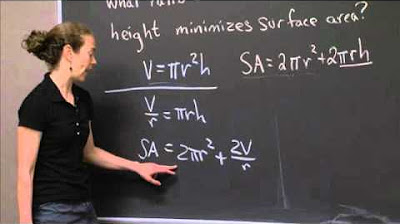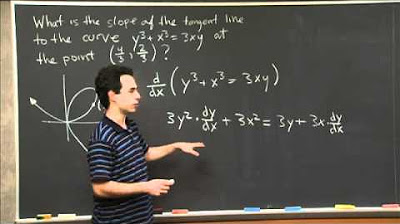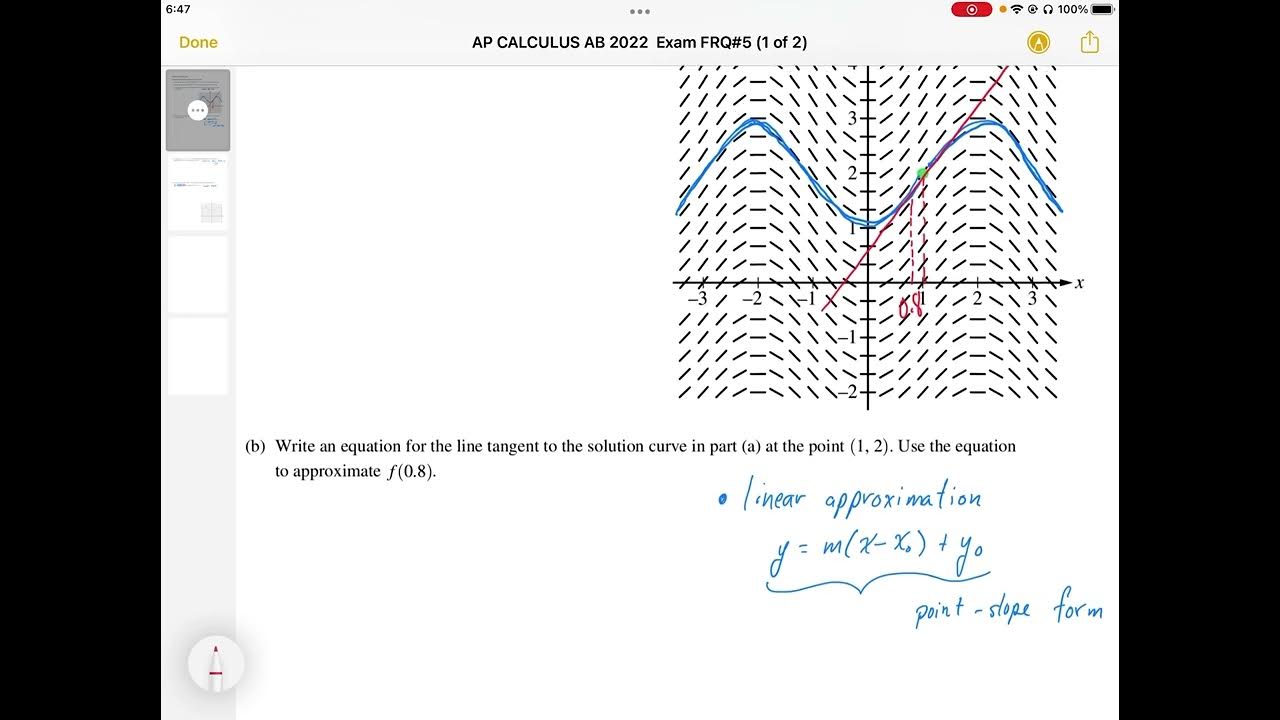Minimum Triangle Area | MIT 18.01SC Single Variable Calculus, Fall 2010
TLDRIn this educational video, the professor introduces an advanced optimization problem involving the area of triangles formed by lines through a fixed point (8, 4) intersecting the coordinate axes. The goal is to find the line with the smallest possible triangle area. The solution involves using the point-slope form of a line, expressing the triangle's dimensions in terms of the line's slope, and then differentiating the area function with respect to the slope to find the minimum. The correct slope that minimizes the area is identified as -1/2, and the video concludes with a hint on how to find the exact dimensions of the triangle.
Takeaways
- 📚 The video is a recitation on an optimization problem involving the area of triangles formed by lines through a specific point.
- 📐 The point in question is (8, 4), and the problem requires finding the dimensions of a triangle that minimizes its area with the hypotenuse passing through this point.
- 🔍 The problem involves an optimization equation (area) and a constraint equation (the line must pass through (8, 4)).
- 📈 The area of the triangle is expressed as 1/2 * base * height, where the base and height are determined by the line's slope.
- 📉 The line's equation is derived using the point-slope form, with the point (8, 4) and an unknown slope 'm'.
- 📍 The x and y intercepts of the line are calculated based on the slope 'm', which in turn determines the triangle's dimensions.
- 🔢 The area is expressed in terms of 'm' by substituting the x and y values derived from the line's equation.
- 📝 The derivative of the area with respect to 'm' is taken to find the slope that minimizes the area.
- 📉 The derivative is set to zero and solved to find the critical points, which are potential solutions for the optimization problem.
- ✂️ Upon solving, two potential slopes are found: m = 1/2 and m = -1/2. However, only m = -1/2 is geometrically feasible for forming a triangle with the axes.
- 📏 The extreme values of 'm' (approaching vertical or horizontal) result in areas that approach infinity, indicating they are not minima.
- 🔑 The final step involves evaluating the x and y intercepts at m = -1/2 to find the exact dimensions of the triangle that minimizes the area.
Q & A
What is the main objective of the optimization problem discussed in the video?
-The main objective is to find the dimensions of a triangle formed by lines passing through the point (8, 4) that minimize the area of the triangle.
What are the two key equations used in solving optimization problems as mentioned in the script?
-The two key equations are the constraint equation and the optimizing equation. In this case, the constraint is that the line must pass through the point (8, 4), and the optimizing equation is the area of the triangle.
How is the area of the triangle expressed in the script?
-The area of the triangle is expressed as 1/2 times the base times the height, or in terms of variables, 1/2 times x times y.
What is the point-slope form of the line equation used in the script, and why is it relevant?
-The point-slope form used is y - 4 = m(x - 8). It is relevant because it represents the line that passes through the point (8, 4) with an unknown slope m.
How are the x and y values of the triangle's vertices related to the slope m?
-The x and y values are determined by the slope m. When y is 0, x is calculated as -4/m + 8. When x is 0, y is calculated as -8m + 4.
What is the strategy for finding the dimensions that minimize the area of the triangle?
-The strategy involves using the constraint equation to express x and y in terms of the slope m, then substituting these expressions into the area equation, and finally differentiating the area with respect to m to find the minimum.
What algebraic manipulation is performed on the area equation before taking the derivative?
-The area equation is simplified by multiplying out the terms and combining like terms to make it easier to differentiate with respect to m.
What is the derivative of the area equation with respect to m, and what does setting it to zero signify?
-The derivative of the area equation with respect to m is -32m + 16/m^2. Setting it to zero signifies finding the critical points where the area could potentially be minimized or maximized.
Why is m = 1/2 not a valid solution for the optimization problem?
-M = 1/2 is not valid because it would result in a line with a positive slope that does not form a triangle with the x and y axes, thus not meeting the problem's requirements.
How does the professor determine that m = -1/2 is the correct slope for minimizing the area?
-The professor determines that m = -1/2 is correct by considering the geometric implications of the slope and by observing that the area approaches infinity as the slope approaches vertical or horizontal positions, which are the extreme values of m.
What final step is suggested to complete the problem after finding the optimal slope?
-The final step suggested is to evaluate x and y at the optimal slope m = -1/2 to find the exact dimensions of the triangle that minimize the area.
Outlines
📚 Introduction to Optimization Problem
The professor begins by welcoming students to a recitation session focused on an optimization problem involving triangles formed by lines passing through a specific point, (8, 4), intersecting with the x and y axes. The objective is to find the dimensions of such a triangle that minimize its area. The professor introduces the concept of using a point to draw a line and the importance of the hypotenuse going through the given point. Students are encouraged to pause the video to attempt the problem before continuing to the solution.
🔍 Deriving the Area Equation and Applying the Constraint
In this paragraph, the professor explains the process of solving the optimization problem by first identifying the need for an optimizing equation, which in this case is the area of the triangle. The area is expressed as 1/2 times the base times the height, or 1/2 times x times y, where x and y are determined by the slope (m) of the line passing through the point (8, 4). The professor then demonstrates how to use the constraint equation to express x and y in terms of m. By substituting these expressions into the area equation, the professor simplifies the problem to a single variable optimization, focusing on the slope m.
📉 Optimizing the Area by Finding the Slope
The professor proceeds to optimize the area by taking the derivative of the area equation with respect to the slope (m) and setting it to zero to find the critical points. After simplifying the algebraic expression, the derivative is taken, and the resulting equation is solved to find m = ±1/2. The professor then uses geometric reasoning to eliminate m = 1/2 as a possibility, concluding that m = -1/2 is the correct slope for the line that minimizes the area of the triangle. The paragraph concludes with a brief mention of how to find the actual dimensions of the triangle using the determined slope, but the professor chooses to leave this as an exercise for the students.
Mindmap
Keywords
💡Optimization Problem
💡Triangle
💡Area
💡Constraint
💡Point-Slope Form
💡Slope
💡Derivative
💡Base and Height
💡Algebra
💡Second Derivative Test
💡Extreme Values
Highlights
Introduction to an optimization problem involving minimizing the area of triangles formed by lines passing through a fixed point (8, 4).
Explanation of the problem setup and the importance of understanding the given point as a constraint for the hypotenuse of the triangle.
Illustration of how to draw a line through the point (8, 4) to form a triangle with the x and y axes.
Introduction of the optimizing equation as the area of the triangle, expressed as 1/2 base times height.
Discussion on the necessity of using a constraint equation due to the presence of two variables in the area formula.
Derivation of the line equation in point-slope form using the point (8, 4) and an unknown slope m.
Geometric interpretation of how the slope m determines the x and y intercepts of the line.
Expression of the area of the triangle in terms of the slope m by substituting x and y with expressions involving m.
Simplification of the area expression to facilitate easier differentiation with respect to m.
Differentiation of the area with respect to the slope m to find the critical points for optimization.
Setting the derivative equal to zero to solve for the value of m that minimizes the area.
Solution of the derivative equation yielding m = ±1/2, with a discussion on the physical meaning of these solutions in the context of the problem.
Elimination of m = 1/2 as a viable solution based on geometric reasoning and the problem constraints.
Confirmation that m = -1/2 is the correct solution that minimizes the area of the triangle.
Geometric argument explaining why extreme values of m (vertical or horizontal lines) result in infinitely large areas.
Brief mention of the second derivative test as an alternative method to confirm the minimum, though not elaborated upon in the video.
Final step of finding the dimensions of the triangle by evaluating x and y at the optimal m = -1/2.
Conclusion of the problem-solving process with an invitation for the viewer to complete the final steps.
Transcripts
Browse More Related Video

2011 Calculus AB free response #3 (a & b) | AP Calculus AB | Khan Academy

Maximum Surface Area | MIT 18.01SC Single Variable Calculus, Fall 2010

Implicit Differentiation | MIT 18.01SC Single Variable Calculus, Fall 2010

Equation of a normal line [IB Maths AI SL/HL]

Calculus 1: Tangent and Normal Lines Example Problems

AP CALCULUS AB 2022 Exam Full Solution FRQ#5(a,b)
5.0 / 5 (0 votes)
Thanks for rating: